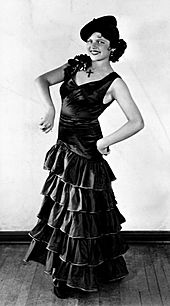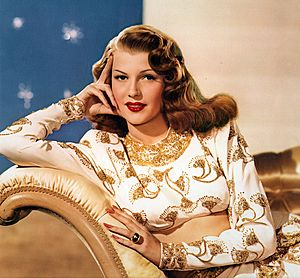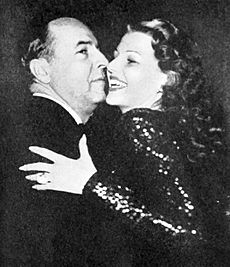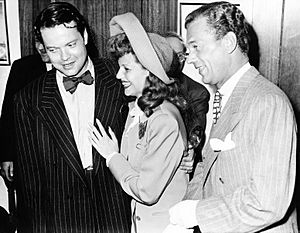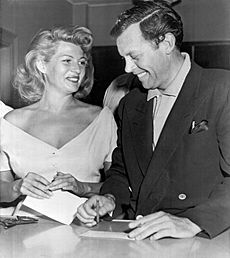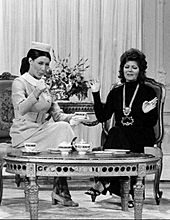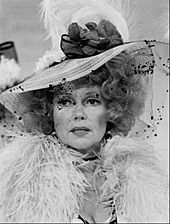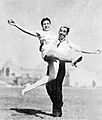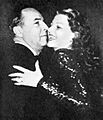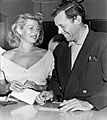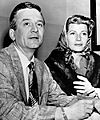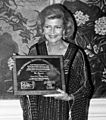Rita Hayworth facts for kids
Quick facts for kids
Rita Hayworth
|
|
|---|---|
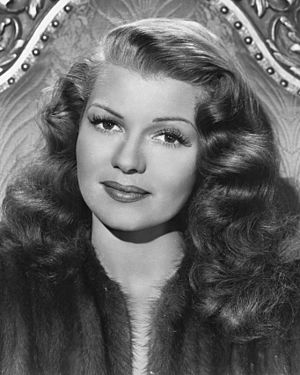
Hayworth in 1947
|
|
| Born |
Margarita Carmen Cansino
October 17, 1918 New York City, U.S.
|
| Died | May 14, 1987 (aged 68) New York City, U.S.
|
| Cause of death | Alzheimer's disease |
| Resting place | Holy Cross Cemetery, Culver City |
| Occupation |
|
| Years active | 1931–1972 |
| Political party | Democratic |
| Spouse(s) |
Edward C. Judson
(m. 1937; div. 1942)Dick Haymes
(m. 1953; div. 1955)James Hill
(m. 1958; div. 1961) |
| Children | 2, including Yasmin Aga Khan |
| Parents |
|
| Relatives |
|
| Signature | |
Rita Hayworth (born Margarita Carmen Cansino; October 17, 1918 – May 14, 1987) was an American actress, dancer, and producer. She became very famous in the 1940s, starring in 61 films over 37 years. People called her a "glamorous screen idol" of the 1940s. She was also a popular pin-up girl for soldiers during World War II.
Hayworth is best known for her role in the 1946 movie Gilda, where she played a strong female character. She also starred in films like Only Angels Have Wings (1939) and The Strawberry Blonde (1941). She made two dance films with Fred Astaire, You'll Never Get Rich (1941) and You Were Never Lovelier (1942). Astaire once said she was his favorite dance partner. She also starred with Gene Kelly in the musical Cover Girl (1944). The American Film Institute lists her as one of the top 25 female movie stars of all time.
In 1980, Hayworth was diagnosed with early-onset Alzheimer's disease. This illness led to her death in 1987 when she was 68. When her illness became public, it helped people learn more about Alzheimer's. It also helped raise money for research into the disease.
Contents
Early Life and Dance Training
Rita Hayworth was born Margarita Carmen Cansino in Brooklyn, New York. She was the oldest child of two dancers. Her father, Eduardo Cansino, was from Spain. Her mother, Volga Hayworth, was American with Irish and English family. They got married in 1917 and also had two sons. Her uncle, Vinton Hayworth, was also an actor.
Margarita's father wanted her to be a professional dancer. Her mother hoped she would become an actress. Her grandfather, Antonio Cansino, was a famous Spanish dancer. He taught Rita her first dance lesson. Hayworth later said, "From the time I was three and a half... I was given dance lessons." She added, "I didn't like it very much... but I didn't have the courage to tell my father."
She took dance classes every day for several years. Before her fifth birthday, she performed in a Broadway show called The Greenwich Village Follies. In 1926, at age eight, she was in a short film for Warner Bros. called La Fiesta.
In 1927, her father moved the family to Hollywood. He believed dancing could be part of movies. He opened his own dance studio and taught stars like James Cagney.
In 1931, Eduardo Cansino started a dance act with his 12-year-old daughter called the Dancing Cansinos. Her brown hair was dyed black to make her look older. Because she was too young to work in California, her father took her to perform in Tijuana, Mexico. Tijuana was a popular tourist spot for people from Los Angeles. Rita never finished high school, but she did complete ninth grade.
At 16, Margarita (Hayworth) had a small part in the film Cruz Diablo (1934). This led to another small role in In Caliente (1935). She danced with her father in places like the Foreign and Caliente clubs. Winfield Sheehan, head of Fox Film Corporation, saw her dance. He quickly signed her to a six-month contract at Fox. She was called Rita Cansino then.
Career Highlights
Starting in Hollywood
At Fox, Rita Cansino played small roles, often as a foreign character. In 1934, at 16, she danced in Dante's Inferno (1935). She got a contract in February 1935. Her first speaking role was in Under the Pampas Moon (1935). She also played an Egyptian girl in Charlie Chan in Egypt (1935).
When Fox merged with 20th Century Fox, her contract was not renewed. A salesman named Edward C. Judson saw her potential. He helped her get small roles in other films. She then signed a seven-year contract with Columbia Pictures.
The head of Columbia, Harry Cohn, thought her image was too "Mediterranean." He also thought her last name sounded too Spanish. Judson advised her to change her name. Rita Cansino became Rita Hayworth, using her mother's maiden name. This made her seem more "American." She also changed her hair to dark red and changed her hairline.
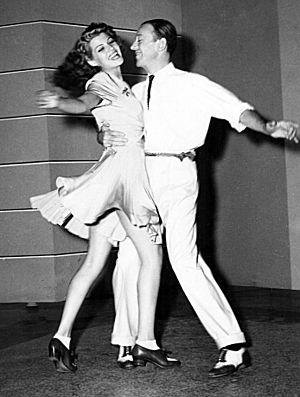
In 1939, she got an important role in Only Angels Have Wings with Cary Grant. In 1940, she appeared on the cover of Life magazine. She also starred with James Cagney in The Strawberry Blonde (1941).
She returned to Columbia and starred in the musical You'll Never Get Rich (1941) with Fred Astaire. This film was very successful. They made another film, You Were Never Lovelier, the next year. Astaire said their dancing together was "absolute magnetism." He called Hayworth his favorite dance partner.
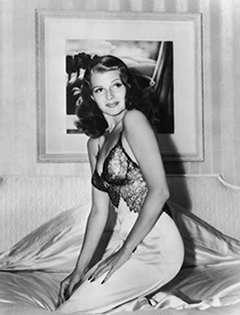
In August 1941, Hayworth was featured in a famous Life magazine photo. This photo made her one of the most popular pin-up girls during World War II. Her picture was the most requested pin-up photo for two years.
In 1942, Hayworth visited Brazil as a "cultural ambassador" for the U.S. government. She also broadcast to South America on the CBS radio network.
Becoming a Top Star
Hayworth was the main star in Cover Girl (1944). This film made her Columbia's top star of the 1940s. She was also the first of only six women to dance on screen with both Gene Kelly and Fred Astaire. Hayworth said her films with Fred Astaire and Cover Girl were the "jewels of my life."
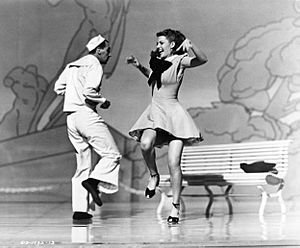
For three years starting in 1944, Hayworth was one of the world's top box-office attractions. She was skilled in many dance styles. Columbia continued to show off her dancing in films like Tonight and Every Night (1945) and Down to Earth (1947).
Her most famous role was in Gilda (1946) with Glenn Ford. This role made her a cultural icon.
While Gilda was in theaters, an atomic bomb was tested. It was reported that the bomb would have an image of Hayworth on it. This was meant as a compliment, but Hayworth was very upset. Her husband at the time, Orson Welles, said she was "almost insane" with anger. He tried to tell her it was a tribute from the flight crew. The fourth atomic bomb ever detonated had a photo of Hayworth on it, with the nickname "Gilda."
Hayworth's performance in Welles's 1947 film The Lady from Shanghai was praised by critics. However, the film did not do well at the box office. Some blamed this on Hayworth's famous red hair being cut short and bleached blonde for the role. Harry Cohn was very angry about this change.
In 1947, Life magazine called her "The Love Goddess." Her next film, The Loves of Carmen (1948), was a big success. She also started her own production company, The Beckworth Corporation.
Life as a Princess and Return to Hollywood
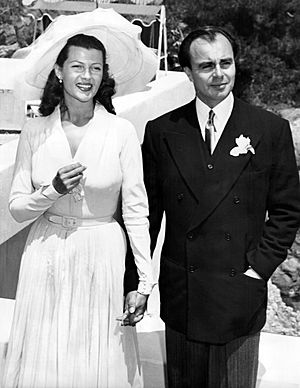
In 1948, Rita Hayworth met Prince Aly Khan in Cannes. They dated for a year and married on May 27, 1949. Hayworth left Hollywood and moved to France. Their wedding was a huge news event. She became the first Hollywood actress to marry a prince. On December 28, 1949, they had a daughter, Princess Yasmin Aga Khan.
Hayworth wanted a new life away from Hollywood. But Aly Khan's busy lifestyle was difficult for her. She found it hard to fit in with his friends and learn French. In 1951, Hayworth returned to New York with her daughters. They tried to make their marriage work, but they divorced in 1953.
After her marriage to Khan ended, Rita Hayworth returned to Hollywood. She starred in her "comeback" film, Affair in Trinidad (1952), again with Glenn Ford. She had some disagreements with Harry Cohn, but the film was very popular. It earned more money than Gilda.
She continued to star in successful films. In 1953, she made Salome and Miss Sadie Thompson. She took a break from movies for four years. When she returned for Fire Down Below (1957), Kim Novak was Columbia's top female star. Her last musical was Pal Joey (1957) with Frank Sinatra. After this film, Hayworth left Columbia for good.
She received good reviews for her roles in Separate Tables (1958) and The Story on Page One (1960). She continued acting throughout the 1960s. Her last film was The Wrath of God (1972), a western. She also made funny appearances on TV shows like Laugh In and The Carol Burnett Show in the 1970s.
Challenges with Columbia Pictures
Hayworth had a difficult relationship with Columbia Pictures for many years. In 1943, she was suspended without pay for nine weeks. This was because she refused to appear in a film. At that time, actors under contract could not choose their movies.
In 1947, Hayworth's new contract gave her a salary of $250,000 plus half of the films' profits. In 1951, she left Hollywood to marry Prince Aly Khan. She was suspended for not showing up for work on the film Affair in Trinidad. In 1952, she refused to work because she did not like the script.
In 1955, she sued Columbia Pictures to end her contract. She also asked for her $150,000 salary. She said a film she was supposed to be in did not start on time. Harry Cohn was known as a tough boss. He had invested a lot in Hayworth.
Years later, Hayworth still felt upset about how she was treated by Cohn and Columbia. She was also bothered that the studio never trained her to sing. She often appeared to sing in her films, but someone else's voice was usually used. This made her embarrassed when soldiers at USO shows asked her to sing.
Public Image
Hayworth was a top glamour star in the 1940s. She was a pin-up girl for soldiers and a beauty icon for women. She was 5 feet 6 inches tall and weighed about 120 pounds. She reportedly changed her hair color eight times for eight different movies.
In 1949, her lips were voted the best in the world. She had a modeling contract with Max Factor to promote their makeup.
Personal Life
Marriages and Family
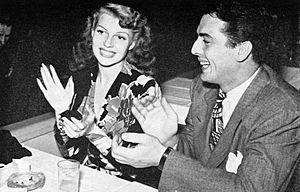
Rita Hayworth's two younger brothers, Eduardo Cansino Jr. and Vernon Cansino, both served in World War II. Eduardo Jr. also became an actor.
Hayworth was married and divorced five times. She had two grandsons.
Relationship with Glenn Ford
Hayworth also had a long-term friendship with Glenn Ford. They started their relationship during the filming of Gilda in 1945. Ford later moved next door to her in Beverly Hills in 1960. They remained close for many years.
Spouses
Edward Charles Judson
In 1937, when Hayworth was 18, she married Edward C. Judson. He was more than twice her age. He helped start her acting career and became her manager. Hayworth said he helped her career but also took her money. She filed for divorce from him in 1942.
Orson Welles
Hayworth married Orson Welles on September 7, 1943. She announced the wedding just one day before it happened. For the ceremony, she wore a beige suit and a white blouse. A few hours after marrying, they went back to work. They had a daughter, Rebecca, born in 1944. They divorced in 1947.
Prince Aly Khan
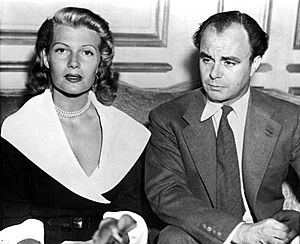
In 1948, Hayworth left her film career to marry Prince Aly Khan. He was the son of Aga Khan III, a leader of the Ismaili community. They married on May 27, 1949.
Aly Khan and his family were very involved in horse racing. Hayworth became a member of the Del Mar Thoroughbred Club. Her horse, Double Rose, won several races in France.
In 1951, while still married, Khan was seen dancing with another actress. Hayworth threatened to divorce him. She moved to Nevada to get a divorce. She filed for divorce from Khan on September 2, 1951. Hayworth wanted their daughter, Princess Yasmin, to be raised as a Christian. In January 1953, Hayworth was granted a divorce.
Dick Haymes
When Hayworth met Dick Haymes, his singing career was slowing down. He had money problems because he owed child support to his former wives. He was also facing deportation from the U.S. Haymes hoped Hayworth could help him stay in the country. Hayworth ended up paying most of his debts.
They married on September 24, 1953, in Las Vegas. After two difficult years, Hayworth left him.
James Hill
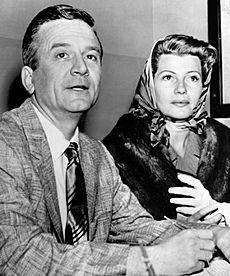
Hayworth started a relationship with film producer James Hill. They married on February 2, 1958. He cast her in one of her last major films, Separate Tables. This film was popular. Hayworth filed for divorce on September 1, 1961. Hill later wrote a book saying their marriage ended because he wanted her to keep making movies, but she wanted them both to retire.
Health Challenges
In 1972, 54-year-old Hayworth wanted to stop acting but needed money. She agreed to film The Wrath of God. This experience showed her poor health. She had trouble remembering her lines, so her scenes were filmed one line at a time. She agreed to make one more movie, but her health got worse. She left the set and returned to the U.S. She never acted again.
In March 1974, both of her brothers died within a week, which made her very sad. In January 1976, at London's Heathrow Airport, Hayworth had an angry outburst on a flight. This caused negative publicity. She was later diagnosed with Alzheimer's disease.
By July 1981, Hayworth's health had gotten so bad that a judge ruled her daughter, Princess Yasmin Aga Khan, should care for her. Hayworth lived near her daughter in New York City. Yasmin arranged for her mother's care. When asked about her mother, Yasmin said, "She's still beautiful. But it's a shell."
In 1983, Rebecca Welles visited her mother for the first time in seven years. Orson Welles, Rebecca's father, worried about the visit. He said, "Rita barely knows me now." He recalled seeing her three years before. He said, "I could see that she realized who I was, and she began to cry quietly."
In an interview before his death in 1985, Welles called Hayworth "one of the dearest and sweetest women that ever lived."
Political Views
Hayworth was a lifelong Democrat. She was active in the Hollywood Democratic Committee. She also supported Franklin Delano Roosevelt in the 1944 presidential election.
Religion
Hayworth was a Catholic. Her marriage to Prince Aly Khan was considered "illicit" by Pope Pius XII.
Death
Rita Hayworth fell into a semi-coma in February 1987. She died at age 68 on May 14, 1987, at her home in Manhattan. She died from problems related to Alzheimer's disease.
Her funeral service was held on May 18, 1987. She was buried at Holy Cross Cemetery, Culver City. Her headstone includes her daughter Yasmin's words: "To yesterday's companionship and tomorrow's reunion."
Filmography
| Year | Title | Role | Notes | Ref. |
|---|---|---|---|---|
| 1926 | La Fiesta | Short; credited as Rita Cansino | ||
| 1934 | Cruz Diablo | Extra | Uncredited | |
| 1935 | In Caliente | Credited as Rita Cansino | ||
| Under the Pampas Moon | Carmen | |||
| Charlie Chan in Egypt | Nayda | |||
| Dante's Inferno | Dancer | |||
| Piernas de seda | Ballerina | Uncredited | ||
| Hi, Gaucho! | Dolores | |||
| Paddy O'Day | Tamara Petrovitch | Credited as Rita Cansino | ||
| 1936 | Professional Soldier | Gypsy Dancer | ||
| Human Cargo | Carmen Zoro | |||
| Dancing Pirate | Specialty Dancer | Uncredited | ||
| Meet Nero Wolfe | Maria Maringola | Credited as Rita Cansino | ||
| Rebellion | Paula Castillo | Alternative title: Lady from Frisco Credited as Rita Cansino |
||
| 1937 | Old Louisiana | Angela Gonzales | Alternative title: Louisiana Gal Credited as Rita Cansino |
|
| Hit the Saddle | Rita | Credited as Rita Cansino | ||
| Trouble in Texas | Carmen Serano | |||
| Criminals of the Air | Rita Owens | |||
| Girls Can Play | Sue Collins | |||
| The Game That Kills | Betty Holland | |||
| Life Begins with Love | Dinner Guest's Girl Friend | Uncredited | ||
| Paid to Dance | Betty Morgan | Alternative title: Hard to Hold | ||
| The Shadow | Mary Gillespie | |||
| 1938 | Who Killed Gail Preston? | Gail Preston | ||
| Special Inspector | Patricia Lane | Alternative title: Across the Border | ||
| There's Always a Woman | Mary—Ketterling's Secretary | Uncredited | ||
| Convicted | Jerry Wheeler | |||
| Juvenile Court | Marcia Adams | |||
| The Renegade Ranger | Judith Alvarez | |||
| 1939 | Homicide Bureau | J.G. Bliss | ||
| The Lone Wolf Spy Hunt | Karen | |||
| Only Angels Have Wings | Judy MacPherson | |||
| 1940 | Music in My Heart | Patricia O'Malley | ||
| Blondie on a Budget | Joan Forrester | |||
| Susan and God | Leonora Stubbs | |||
| The Lady in Question | Natalie Roguin | |||
| 1940 | Angels Over Broadway | Nina Barona | ||
| 1941 | The Strawberry Blonde | Virginia Brush | ||
| Affectionately Yours | Irene Malcolm | |||
| Blood and Sand | Doña Sol | |||
| You'll Never Get Rich | Sheila Winthrop | |||
| 1942 | My Gal Sal | Sally Elliott | ||
| Tales of Manhattan | Ethel Halloway | |||
| You Were Never Lovelier | Maria Acuña | |||
| 1944 | Cover Girl | Rusty Parker/Maribelle Hicks | ||
| 1945 | Tonight and Every Night | Rosalind Bruce | ||
| 1946 | Gilda | Gilda Mundson Farrell | ||
| 1947 | Down to Earth | Terpsichore/Kitty Pendleton | ||
| The Lady from Shanghai | Elsa Bannister | |||
| 1948 | The Loves of Carmen | Carmen | Also producer (uncredited) | |
| 1952 | Affair in Trinidad | Chris Emery | Also producer (uncredited) | |
| 1953 | Salome | Princess Salome | Alternative title: Salome: The Dance of the Seven Veils Also producer (uncredited) |
|
| Miss Sadie Thompson | Sadie Thompson | |||
| 1957 | Fire Down Below | Irena | ||
| Pal Joey | Vera Prentice-Simpson | |||
| 1958 | Separate Tables | Ann Shankland | ||
| 1959 | They Came to Cordura | Adelaide Geary | ||
| The Story on Page One | Josephine Brown/Jo Morris | |||
| 1961 | The Happy Thieves | Eve Lewis | Also executive producer | |
| 1964 | Circus World | Lili Alfredo | ||
| 1965 | The Money Trap | Rosalie Kenny | ||
| 1966 | The Poppy Is Also a Flower | Monique Marko | Television film | |
| 1967 | The Rover | Aunt Caterina | Alternative title: L'avventuriero | |
| 1970 | Road to Salina | Mara | Alternative title: La route de Salina | |
| The Naked Zoo | Mrs. Golden | |||
| 1971 | The Carol Burnett Show | Herself | TV series (Episode #4.20) | |
| Rowan & Martin's Laugh-In | TV series (Episode #5.3) | |||
| 1972 | The Wrath of God | Señora De La Plata |
Awards and Recognition
Hayworth was nominated for a Golden Globe Award for her role in Circus World (1964).
In 1978, she received the first National Screen Heritage Award. This award was given by the National Film Society.
In 1999, the American Film Institute named Hayworth one of the top 25 greatest female stars of Classic Hollywood cinema.
Legacy and Impact
When Rita Hayworth's illness became public, it brought a lot of attention to Alzheimer's disease. At the time, not many people knew about this illness. Her story helped increase government funding for Alzheimer's research.
The Rita Hayworth Gala is an event that raises money for the Alzheimer's Association. It is held every year in Chicago and New York City. Her daughter, Princess Yasmin Aga Khan, started the program in 1985 to honor her mother. She hosts the events and supports Alzheimer's charities. By August 2017, these events had raised over $72 million.
In 2016, a campaign began to ask the United States Postal Service to create a stamp featuring Hayworth. There were also efforts to have an honorary Academy Award given in her memory. Her daughter, the Alzheimer's Association, and many famous people supported these efforts. The goal was to have the stamp and award by October 17, 2018, which would have been Hayworth's 100th birthday.
Images for kids
-
With Fred Astaire in You Were Never Lovelier (1942).
-
Iconic 1941 photograph of Hayworth for Life magazine.
-
Hayworth and choreographer Jack Cole in Tonight and Every Night (1945).
-
Hayworth and Prince Aly Khan at their wedding reception in the garden of the Château de l'Horizon near Cannes, 1949.
-
Hayworth and Aly Khan in Paris in 1952, before their divorce.
-
Hayworth and Victor Mature at the Hollywood Palladium, 1942.
-
Wedding of Orson Welles and Hayworth with best man Joseph Cotten, 1943.
-
James Hill and Hayworth obtaining their marriage license in Santa Monica, 1958.
-
Hayworth and Carol Burnett on The Carol Burnett Show (1971).
-
Lily Tomlin and Hayworth on Rowan & Martin's Laugh-In (1971).
-
Hayworth reprising the role of Sadie Thompson on Laugh-In (1971).
See also
 In Spanish: Rita Hayworth para niños
In Spanish: Rita Hayworth para niños


